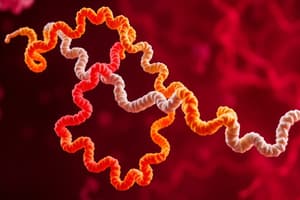Podcast
Questions and Answers
What is the totality of an organism's chemical reactions?
What is the totality of an organism's chemical reactions?
- Metabolism (correct)
- Cellular respiration
- Enzymes
- Bioluminescence
Which type of pathway releases energy by breaking down complex molecules into simpler compounds?
Which type of pathway releases energy by breaking down complex molecules into simpler compounds?
- Catabolic pathway (correct)
- Photosynthetic pathway
- Cellular respiration pathway
- Anabolic pathway
Which process consumes energy to build complex molecules from simpler ones?
Which process consumes energy to build complex molecules from simpler ones?
- Bioluminescence
- Catabolic pathway
- Cellular respiration
- Anabolic pathway (correct)
What is the study of how organisms manage their energy resources called?
What is the study of how organisms manage their energy resources called?
Which energy is associated with random movement of atoms or molecules?
Which energy is associated with random movement of atoms or molecules?
Where does cellular respiration occur?
Where does cellular respiration occur?
What is the primary function of enzymes in metabolic pathways?
What is the primary function of enzymes in metabolic pathways?
In which organelle are enzymes for cellular respiration typically located?
In which organelle are enzymes for cellular respiration typically located?
What type of reaction is characterized by the breakdown of molecules to release energy?
What type of reaction is characterized by the breakdown of molecules to release energy?
What is the result of an investment of activation energy in a spontaneous reaction?
What is the result of an investment of activation energy in a spontaneous reaction?
What is the purpose of ATP in cellular work?
What is the purpose of ATP in cellular work?
What is the role of enzymes in lowering activation energy?
What is the role of enzymes in lowering activation energy?
What type of reaction absorbs free energy from its surroundings and is nonspontaneous?
What type of reaction absorbs free energy from its surroundings and is nonspontaneous?
What does the first law of thermodynamics state about the energy of the universe?
What does the first law of thermodynamics state about the energy of the universe?
In ATP hydrolysis, where is the energy released from?
In ATP hydrolysis, where is the energy released from?
Which type of pathway releases energy by breaking down complex molecules into simpler compounds?
Which type of pathway releases energy by breaking down complex molecules into simpler compounds?
What defines the feature of life that metabolism is never at equilibrium?
What defines the feature of life that metabolism is never at equilibrium?
Which reaction has a net release of free energy and is spontaneous?
Which reaction has a net release of free energy and is spontaneous?
Which law of thermodynamics states that every energy transfer increases the entropy of the universe?
Which law of thermodynamics states that every energy transfer increases the entropy of the universe?
What is the measure of a system's instability and its tendency to change to a more stable state?
What is the measure of a system's instability and its tendency to change to a more stable state?
Cells manage energy resources through __________, using an exergonic process to drive an endergonic one.
Cells manage energy resources through __________, using an exergonic process to drive an endergonic one.
Which reaction absorbs free energy from its surroundings and is nonspontaneous?
Which reaction absorbs free energy from its surroundings and is nonspontaneous?
Flashcards are hidden until you start studying
Study Notes
The Energy of Life
- The living cell is a miniature chemical factory where thousands of reactions occur, extracting energy and applying energy to perform work.
Metabolism
- Metabolism is the totality of an organism's chemical reactions, an emergent property of life that arises from interactions between molecules within the cell.
- Metabolic pathways begin with a specific molecule and end with a product, with each step catalyzed by a specific enzyme.
Catabolic and Anabolic Pathways
- Catabolic pathways release energy by breaking down complex molecules into simpler compounds, such as cellular respiration (the breakdown of glucose in the presence of oxygen).
- Anabolic pathways consume energy to build complex molecules from simpler ones, such as the synthesis of protein from amino acids.
Bioenergetics
- Bioenergetics is the study of how organisms manage their energy resources.
- Energy can be converted from one form to another, and exists in various forms, including kinetic energy (associated with motion), heat (thermal energy), potential energy (possessed due to location or structure), and chemical energy (potential energy available for release in a chemical reaction).
Enzymes and Metabolic Pathways
- Enzymes act as catalysts, lowering the activation energy required for a chemical reaction to occur.
- Specific localization of enzymes within the cell helps bring order to metabolic pathways.
- Enzymes can act as structural components of membranes or reside in specific organelles, such as mitochondria.
Thermodynamics
- The first law of thermodynamics states that energy can be transferred and transformed, but not created or destroyed.
- The second law of thermodynamics states that every energy transfer or transformation increases the entropy (disorder) of the universe.
- Living organisms create ordered structures from less ordered materials, but the universe's total entropy increases.
Free-Energy Change and Spontaneity
- The free-energy change (∆G) of a reaction determines whether it occurs spontaneously or not.
- A spontaneous process occurs without energy input and increases the entropy of the universe.
- Only processes with a negative ∆G are spontaneous and can perform work.
ATP and Energy Coupling
- ATP (adenosine triphosphate) is the cell's energy shuttle, composed of ribose, adenine, and three phosphate groups.
- Hydrolysis of ATP releases energy, which is used to drive endergonic reactions, powering cellular work such as mechanical, transport, and chemical work.
Studying That Suits You
Use AI to generate personalized quizzes and flashcards to suit your learning preferences.




